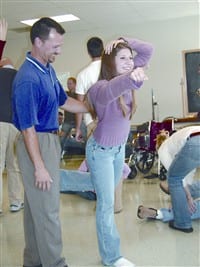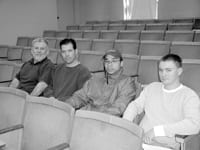A New Spin AXIS Dance Company Teaches The Right Moves To Area Physical Therapy Students
Judith Smith, artistic director of the AXIS Dance Company, says the group chose its name because an axis of a wheel is that point at which all the individual spokes come together.
“It was a nice metaphor for us,” she said.
Smith leads a group of multi-abled dancers in performances and classes across the country, showcasing the diverse talents of dancers with and without disabilities. She said that, when choosing a name for the company, she and her fellow founding members didn’t want to focus on wheelchairs, canes, or crutches. But the idea of a point at which several moving parts come together by moving and working in their own way seemed to fit.
AXIS was formed in 1987 as a creative outlet for dancers with varying physical ability. Some members have no disability; others live with some form of paralysis, spinal cord injury, or have lost a limb. Since its inception, the company has become a pioneer of what is called ‘physically integrated dance,’ which specializes in choreography and movements that create seamless performances in spite of physical challenges. AXIS performs for both adult audiences and children, but in recent years has also focused on physically integrated dance classes for students of all ages.
“The class integrates all bodies of all types and gets them moving and dancing together,” said Sean McMahon, a member the company. “The most important aspect is creativity. It teaches that anyone with any kind of body and can move it, and enjoy moving it.” As part of a sponsorship from the New England
Foundation for the Arts, AXIS has been criss-crossing the Northeast giving performances and classes at schools, colleges, and workshops as part of a six-week tour. One stop brought them to American International College, where Smith and three other members of the dance troupe brought second-year physical therapy graduate students through a series of exercises and movements designed to help them better understand dance, its rehabilitative effects, and the specific challenges that face people living with disabilities.
Smith said the dance company’s educational component has gained both momentum and notoriety in recent years, as it sets the group apart from other modern dance ensembles.
“There are probably 30 or 40 groups like us,” she said, “and among modern dance groups that is a small number. But what we do is different because of the education we promote. What we do now is not the same as what we were doing 17-years ago … we’ve grown.”
Conversations in Movement
Smith began her career in dance after a serious car accident that left her paralyzed from the waist down. She admitted that, as a child, she hated dance, preferring instead to hone her skills in equestrian competition. It was only when she began to study improvisational movement as a way to re-teach herself to dress, perform simple tasks, and drive a car that the world of dance opened up for her.
“I wasn’t moving,” she said. “Then I realized that if I looked at movement in different ways, that could help me.”
And for the students nearing the end of their study in physical therapy and gearing up to enter a competitive field, that knowledge can help them as practitioners, she said.
Although AXIS conducts physically integrated movement classes for pupils as young as four or five years-old, the physical therapy students at AIC were able to glean very specific information and skills from the class, in terms of working with patients with disabilities and creative rehabilitation strategies. Some students sat in wheelchairs or used crutches when practicing different exercises, such as ‘conversations of movement,’ during which they were asked to talk with a partner using only their bodies.
“This gives us a broad knowledge of movement,” said Laura Renaud, a physical therapy student as well as a dancer. “Having a decent knowledge of kinesiology (the study of human movement) makes you look at these simple movements in a very different way – as a dancer, you know these things are beneficial even without knowing the terminology. Now I can see the ways we can apply this kind of creative movement to our practice.”
Gail Stern, assistant professor of physical therapy at AIC, said the program is one of many scheduled for PT graduate students to give them exposure to a breadth of topics within the physical therapy field.
“This is a part of the coursework that allows students to look at aspects of the field that aren’t covered in the core curriculum,” she said. “The classes are designed to open students’ eyes to different things.”
In addition to the AXIS dance class, PT students at AIC will also study complementary medicine, a wide range of specific disabilities, and sit in on a seminar that will address physically challenged athletes who participate in extreme sports. Stern said the additional courses round out the students’ course of study as they complete their final year in AIC’s PT program, and also help to teach sensitivity to different physical challenges by exposing the students to many different people in unique situations.
Raising the Bar
Smith agreed, saying that the educational aspect of AXIS underscores the benefits of dance and creative movement that she has experienced firsthand. But as the dancers tour, they also raise awareness of physical disability, and the changes that are needed in school systems, higher education, the arts, and the world at large.
She said many people believe that dancers or other artists and athletes cannot remain active in their field following an injury. She then told the story of a dancer who lost his leg to cancer, only to become a more prolific performer after surgery.
“He really found his center and what he loved about dance,” she said.
Smith also relayed the story of Nadia Adame, an AXIS dancer who was injured in a motor vehicle crash at the age of 14. Adame was turned away from 30 dance programs at universities nationwide, before she received a degree in theater from the University of Colorado. Now, she teaches and choreographs for AXIS, and is often a featured dancer. Smith showed a short video clip of one of Adame’s performances, in which her cane, covered in glitter, is lowered from the ceiling and into her hand so she can begin her routine.
“That’s why we need to build a lot more education in the university system,” she said. “There is no reason she couldn’t have gotten a degree. She’s an amazing dancer.”
Full Integration
As part of its tour, AXIS also performed and conducted classes at Springfield College, Holyoke Community College, Hampshire College, Amherst College and the UMass, in addition to its seminar with AIC’s second-year PT graduate students. The appearances were facilitated by the Fine Arts Center of UMass, which, in collaboration with the New England Foundation for the Arts, pushed to have the dancers appear in the region for an extended period of time.
In the past, AXIS has also received performance and educational grants from several high-profile organizations, including the Christopher Reeve Paralysis Foundation, the Creative Work Fund, and the National Endowment for the Arts. The dance company’s success is not restricted to its work with promoting awareness of physical disability, either; as a modern dance troupe, AXIS has been honored with many prestigious awards including numerous Isadora Duncan Dance Awards and the Key to Creativity, awarded by Oakland, Calif. Mayor Jerry Brown.
Halina Kusleika, assistant director of programming at the Fine Arts Center, said the center’s interest in the group began from a fine arts point of view, and was only heightened after staff learned of the company’s extensive educational work.
“We try to bring a different group to the area each year,” said Kusleika. “We wanted AXIS here for a full-week residency. What they are doing is unique, and it’s getting well known. We wanted to highlight that.”



Comments are closed.